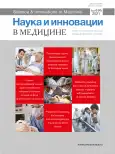Взаимосвязь концентрации эссенциальных химических элементов в цельной крови и слизистой оболочке околоносовых пазух с тяжестью хронического риносинусита у детей
- Авторы: Алексеенко С.И.1,2,3, Дворянчиков В.В.1, Скальный А.В.4,5, Аникин И.А.1,6, Исаченко В.С.7, Тиньков А.А.4,5
-
Учреждения:
- ФГБУ «Санкт-Петербургский научно-исследовательский институт уха, горла, носа и речи» Минздрава России
- ФГБОУ ВПО «Северо-Западный государственный медицинский университет имени И.И. Мечникова» Минздрава России
- ГБУЗ «ДГМКЦ ВМТ имени К.А. Раухфуса»
- ФГАОУ ВО «Первый Московский государственный медицинский университет имени И.М. Сеченова» Минздрава России
- ФГАОУ ВО «Российский университет дружбы народов»
- ГБУЗ «ДГМКЦ ВМТ имени К.А. Раухфуса
- ФГБВОУ ВО «Военно-медицинская академия имени С.М. Кирова» Минобороны России
- Выпуск: Том 6, № 4 (2021)
- Страницы: 9-13
- Раздел: Болезни уха, горла и носа
- URL: https://bakhtiniada.ru/2500-1388/article/view/89448
- DOI: https://doi.org/10.35693/2500-1388-2021-6-4-9-13
- ID: 89448
Цитировать
Полный текст
Аннотация
Цель – изучение взаимосвязи концентрации эссенциальных химических элементов в цельной крови с их содержанием в образцах патологически измененной слизистой оболочки околоносовых пазух и тяжестью хронического риносинусита у детей.
Материал и методы. Проанализированы результаты обследований 154 детей в возрасте от 6 до 17 лет. Из них 88 пациентов имели диагноз «хронический риносинусит» и получили хирургическое лечение в объеме функциональных эндоскопических риносинусохирургических вмешательств. Контрольную группу составили 66 здоровых обследуемых. Оценка качества жизни осуществлялась посредством опросника SNOT-20 (Sino-Nasal Outcome Test-20). Результаты эндоскопического и компьютерно-томографического исследований оценивались по шкалам Lund – Kennedy и Lund – Mackay соответственно. Определение содержания эссенциальных макро- и микроэлементов в цельной крови осуществлялось методом масс-спектрометрии с индуктивно-связанной плазмой.
Результаты. Установлено, что суммарная оценка по SNOT-20 у пациентов с хроническим риносинуситом превышала контрольные значения на 68%. В то же время концентрация кальция, селена, цинка и магния в цельной крови пациентов была ниже таковой в группе здоровых обследуемых на 6%, 28%, 20% и 3% соответственно. Анализ содержания химических элементов в образцах патологически измененной слизистой оболочки околоносовых пазух снижался в следующем ряду: Ca > Mg = Fe > Zn > Cu> Mn > Se. При этом только содержание селена в цельной крови достоверно коррелировало с уровнем данного элемента в интраоперационных биоптатах слизистой оболочки околоносовых пазух. В регрессионных моделях уровень селена в цельной крови был обратно взаимосвязан с оценкой по SNOT-20 и Lund – Mackay.
Выводы. Результаты настоящего исследования свидетельствуют о возможной роли нарушений обмена кальция, магния, цинка и селена в развитии и прогрессировании хронического риносинусита.
Ключевые слова
Полный текст
Открыть статью на сайте журналаОб авторах
Светлана Иосифовна Алексеенко
ФГБУ «Санкт-Петербургский научно-исследовательский институт уха, горла, носа и речи» Минздрава России; ФГБОУ ВПО «Северо-Западный государственный медицинский университет имени И.И. Мечникова» Минздрава России; ГБУЗ «ДГМКЦ ВМТ имени К.А. Раухфуса»
Автор, ответственный за переписку.
Email: svolga-lor@mail.ru
ORCID iD: 0000-0002-3377-8711
канд. мед. наук, доцент, старший научный сотрудник отдела разработки высокотехнологичных методов лечения; доцент кафедры оториноларингологии; заведующая оториноларингологическим отделением
Россия, Санкт-ПетербургВладимир Владимирович Дворянчиков
ФГБУ «Санкт-Петербургский научно-исследовательский институт уха, горла, носа и речи» Минздрава России
Email: v.v.dvoryanchikov@mail.ru
ORCID iD: 0000-0002-0925-7596
д-р мед. наук, профессор, директор
Россия, Санкт-ПетербургАнатолий Викторович Скальный
ФГАОУ ВО «Первый Московский государственный медицинский университет имени И.М. Сеченова» Минздрава России; ФГАОУ ВО «Российский университет дружбы народов»
Email: skalny3@microelements.ru
ORCID iD: 0000-0001-7838-1366
д-р мед. наук, профессор, заведующий кафедрой медицинской элементологии; заведующий лабораторией молекулярной диетологии
Россия, МоскваИгорь Анатольевич Аникин
ФГБУ «Санкт-Петербургский научно-исследовательский институт уха, горла, носа и речи» Минздрава России; ГБУЗ «ДГМКЦ ВМТ имени К.А. Раухфуса
Email: dr-anikin@mail.ru
ORCID iD: 0000-0003-2977-2656
д-р мед. наук, профессор; руководитель отдела разработки и внедрения высокотехнологичных методов лечения
Россия, Санкт-ПетербургВадим Сергеевич Исаченко
ФГБВОУ ВО «Военно-медицинская академия имени С.М. Кирова» Минобороны России
Email: lor_vma@mail.ru
ORCID iD: 0000-0001-9090-0413
д-р мед. наук, доцент, доцент кафедры оториноларингологии
Россия, Санкт-ПетербургАлексей Алексеевич Тиньков
ФГАОУ ВО «Первый Московский государственный медицинский университет имени И.М. Сеченова» Минздрава России; ФГАОУ ВО «Российский университет дружбы народов»
Email: tinkov.a.a@gmail.com
ORCID iD: 0000-0003-0348-6192
канд. мед. наук, доцент кафедры медицинской элементологии; ведущий научный сотрудник лаборатории молекулярной диетологии
Россия, МоскваСписок литературы
- London NR Jr, Lane AP. Innate immunity and chronic rhinosinusitis: What we have learned from animal models. Laryngoscope Investigative Otolaryngology. 2016;1(3):49-56. doi: 10.1002/lio2.21
- Wessels I, Maywald M, Rink L. Zinc as a Gatekeeper of Immune Function. Nutrients. 2017;9(12):1286. doi: 10.3390/nu9121286
- Avery JC, Hoffmann PR. Selenium, Selenoproteins, and Immunity. Nutrients. 2018;10(9):1203. doi: 10.3390/nu10091203
- Healy C, Munoz-Wolf N, Strydom J, et al. Nutritional immunity: the impact of metals on lung immune cells and the airway microbiome during chronic respiratory disease. Respiratory Research. 2021;22(1):133. doi: 10.1186/s12931-021-01722-y
- Unal M, Tamer L, Pata YS, Kilic S, et al. Serum levels of antioxidant vitamins, copper, zinc and magnesium in children with chronic rhinosinusitis. Journal of Trace Elements in Medicine and Biology. 2004;18(2):189-92. doi: 10.1016/j.jtemb.2004.07.005
- Okur E, Gul A, Kilinc M, Kilic MA, et al. Trace elements in nasal polyps. European Archives of Oto-Rhino-Laryngology. 2013;270(8):2245-8. doi: 10.1007/s00405-012-2319-6
- Kim DH, Yeo SW. Effects of normal saline and selenium-enriched hot spring water on experimentally induced rhinosinusitis in rats. International Journal of Pediatric Otorhinolaryngology. 2013;77(1):117-22. doi: 10.1016/j.ijporl.2012.10.008
- Jaspers I, Zhang W, Brighton LE, et al. Selenium deficiency alters epithelial cell morphology and responses to influenza. Free Radical Biology and Medicine. 2007;42(12):1826-37. doi: 10.1016/j.freeradbiomed.2007.03.017
- Suzuki M, Suzuki T, Watanabe M, et al. Role of intracellular zinc in molecular and cellular function in allergic inflammatory diseases. Allergology International. 2021;70(2):190-200. doi: 10.1016/j.alit.2020.09.007
- Woodworth BA, Zhang S, Tamashiro E, et al. Zinc increases ciliary beat frequency in a calcium-dependent manner. American Journal of Rhinology & Allergy. 2010;24(1):6-10. doi: 10.2500/ajra.2010.24.3379
- Roscioli E, Jersmann HP, Lester S, et al. Zinc deficiency as a codeterminant for airway epithelial barrier dysfunction in an ex vivo model of COPD. International Journal of Chronic Obstructive Pulmonary Disease. 2017;12:3503-3510. doi: 10.2147/COPD.S149589
- Price ME, Sisson JH. Redox regulation of motile cilia in airway disease. Redox Biol. 2019;27:101146. doi: 10.1016/j.redox.2019.101146
- Deveci E, Yorgancilar E, Ekinci C, et al. Effects of manganese ethylene-bis-dithiocarbamate (maneb) on rat nasal respiratory mucosa. Acta Medica Mediterranea. 2013;29:875-878.
- Alekseenko SI, Skalny AV, Ajsuvakova OP, et al. Mucociliary transport as a link between chronic rhinosinusitis and trace element dysbalance. Medical Hypotheses. 2019;127:5-10. doi: 10.1016/j.mehy.2019.03.007
Дополнительные файлы






